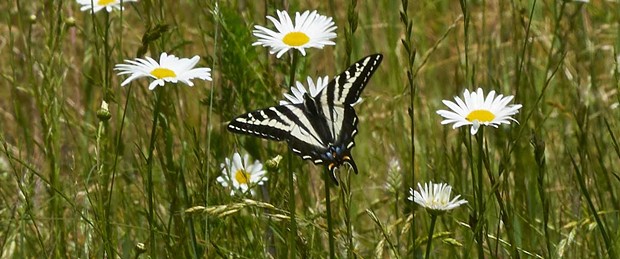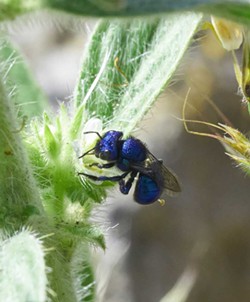[
{
"name": "Top Stories Video Pair",
"insertPoint": "7",
"component": "17087298",
"parentWrapperClass": "fdn-ads-inline-content-block",
"requiredCountToDisplay": "1"
}
]
One good thing about insects as a hobby is there are so many of them and they're everywhere. The high desert environment of central Oregon is so different from our coastal rainforest that it gives opportunities to encounter entirely unfamiliar species. So, I took my cameras on a trip last week. It was easy to add a few critters to my life list.
I spent a lot of time chasing what I thought was an agile and nervous brilliant indigo bee. It turned out to be Parnopes edwardsii, a cuckoo wasp that lays its eggs in the nests of other wasps. When they hatch, they eat either the host wasp larva, the larder its mother provided or both.
At the Mount Mazama overlook on State Route 138, a tiny dark butterfly taunted me, flitting from one strawberry blossom to another until I finally got a shot. It turned out to be a western pine elfin (Callophrys eryphon), something I'm never likely to see in my part of Humboldt County.
Outside of Culver, Oregon, some juniper hairstreak butterflies (Callophrys gryneus) were so intent nectaring on a drab spike of phacelia flowers they paid me almost no heed at all, allowing me to get several nice shots. Researching this butterfly I learned the western juniper (Juniperus occidentalis) on which their caterpillars likely feed are considered an invasive species in central Oregon. The presence of that little butterfly indicates a changing local ecology.
Back to the river
As the weather begrudgingly warms up, more bugs are emerging. Lately along the Van Duzen River, I've noted pale swallowtail (Papilio eurymedon) and Lorquin's admiral (Limenitis lorquini) butterflies among others.
You can find quite a few stonefly (order Plecoptera) exuvia, or cast off husks, near the water's edge as naiads shed their last larval shell and emerge as flying adults.
The most remarkable insect I've seen lately was a male elm sawfly (Cimbex americana). Following a dragonfly into the bushes, I saw what I thought was a giant hornet in the weeds. Dark wings buzzing a deep bass note, it fumbled trying to claw its way up a stalk. I watched as it failed repeatedly and I noted its antennae ended in little clubs. That one feature told me it wasn't a stinging wasp at all but a member of the family Cimbicidae of sawflies. I seldom collect insects but this one seemed seriously impaired and remarkable, so I caught it, took it home, killed and mounted it. It was so large I had to improvise a balsa spreading board to accommodate the thickness and width of its body. Members of the order Hymenoptera, along with ants, bees and wasps, this group eats plants and is totally stingless.
As larvae, sawflies can be serious garden and forest pests. Looking much like moth caterpillars, they are responsible for damage to many crop and ornamental trees and shrubs, including rhododendrons, fruit trees, camellias and roses. Many species feed at night and hide in the leaf litter beneath their chosen hosts during the day, the only clue to their presence is the damage they've done to the leaves of the plant above.
Read more of Anthony Westkamper's entomological adventures on Sundays at www.northcoastjournal.com.
more from the author
-
HumBug: Early Spring Pollinators
- Apr 12, 2020
-
HumBug: A Recipe for History
- Apr 5, 2020
-
HumBug: Bugs in the City
- Mar 29, 2020
- More »

































